
Zoos are a crucial venue for conducting research. Many studies, such as behavioral observations, are challenging to carry out in the wild, for instance, because animals can quickly disappear from sight. Knowledge about physiology, genetics, health, and veterinary care is easier to gather in a controlled environment and with animals accustomed to human contact. We share the insights we gain as much as possible with conservation projects worldwide. We disseminate the findings of scientific research through publications.

Populationmanagement programs aim to maintain healthy reserve populations of animals in zoos. Furthermore, we strive to integrate populationmanagement programs as much as possible with conservation activities in the animals' native countries (in situ).

No zoo has a sufficient number of animals of a single species to establish a viable population. That's why zoos collaborate. The coordination of populationmanagement programs occurs at the European or even international level. Through cooperation and the exchange of animals between different zoos, we can maintain the genetic health of zoo populations. This exchange of animals always takes place on a non-commercial basis. In other words, we do not buy or sell animals.

Within the populationmanagement programs, we collaborate with various EAZA zoos. EAZA stands for 'European Association of Zoos & Aquarias' and is the umbrella organization for European accredited zoos. To be a member of EAZA, a zoo must meet strict requirements, ensuring the quality of European zoos. The populationmanagement programs of EAZA zoos are also known as EEPs, which stands for 'EAZA Ex-situ Programme.' Currently, there are more than four hundred European populationmanagement programs.

The coordinator of a populationmanagement program, together with a committee of experts, determines which animals are allowed to have offspring and need to be exchanged. They also decide which zoo the offspring will go to when they are grown. We use computer software for this, which analyzes the genetics of the population. Additionally, the experts establish long-term policies. For example, how many animals will there be room for in 10 years? Or what needs to happen in the coming years to keep inbreeding in the population low?
At Blijdorp, the following population management programs are coordinated:
- Asian elephants: EEP (population management program of EAZA zoos)
- Red pandas: EEP and the Global Population Management Program (GSMP)
- Tufted deer: EEP
- Egyptian tortoise: EEP
- Rüppell's griffon vulture: EEP
We are proud to welcome healthy offspring of these (critically) endangered animals every year.

Within a populationmanagement program, the focus is on how the zoo population can support wild populations. To determine this, the coordinator assesses the threat level to a species and the reasons behind it, using resources like the IUCN Red List, the world's most comprehensive source of information on species and their conservation status.
Additionally, they examine the size and genetic value of zoo populations globally. Based on this information, the role of a population management program is determined. Such a program might have an educational role or be involved in developing a reserve population that could be useful for reintroductions. Unfortunately, more and more species are facing extinction. Therefore, the role of the population management program is reassessed every five to ten years. This way, population management programs increasingly become part of species conservation efforts in their countries of origin. We follow the 'One Plan Approach' initiated by the IUCN, which aims to connect all global conservation initiatives to create a collective strategy.